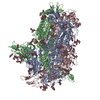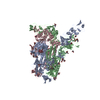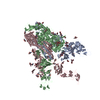+Search query
-Structure paper
| Title | Sialoglycan binding triggers spike opening in a human coronavirus. |
|---|---|
| Journal, issue, pages | Nature, Vol. 624, Issue 7990, Page 201-206, Year 2023 |
| Publish date | Oct 4, 2023 |
 Authors Authors | Matti F Pronker / Robert Creutznacher / Ieva Drulyte / Ruben J G Hulswit / Zeshi Li / Frank J M van Kuppeveld / Joost Snijder / Yifei Lang / Berend-Jan Bosch / Geert-Jan Boons / Martin Frank / Raoul J de Groot / Daniel L Hurdiss /    |
| PubMed Abstract | Coronavirus spike proteins mediate receptor binding and membrane fusion, making them prime targets for neutralizing antibodies. In the cases of severe acute respiratory syndrome coronavirus, severe ...Coronavirus spike proteins mediate receptor binding and membrane fusion, making them prime targets for neutralizing antibodies. In the cases of severe acute respiratory syndrome coronavirus, severe acute respiratory syndrome coronavirus 2 and Middle East respiratory syndrome coronavirus, spike proteins transition freely between open and closed conformations to balance host cell attachment and immune evasion. Spike opening exposes domain S1, allowing it to bind to proteinaceous receptors, and is also thought to enable protein refolding during membrane fusion. However, with a single exception, the pre-fusion spike proteins of all other coronaviruses studied so far have been observed exclusively in the closed state. This raises the possibility of regulation, with spike proteins more commonly transitioning to open states in response to specific cues, rather than spontaneously. Here, using cryogenic electron microscopy and molecular dynamics simulations, we show that the spike protein of the common cold human coronavirus HKU1 undergoes local and long-range conformational changes after binding a sialoglycan-based primary receptor to domain S1. This binding triggers the transition of S1 domains to the open state through allosteric interdomain crosstalk. Our findings provide detailed insight into coronavirus attachment, with possibilities of dual receptor usage and priming of entry as a means of immune escape. |
 External links External links |  Nature / Nature /  PubMed:37794193 / PubMed:37794193 /  PubMed Central PubMed Central |
| Methods | EM (single particle) |
| Resolution | 3.4 - 5.4 Å |
| Structure data | EMDB-16882, PDB-8ohn: EMDB-17076, PDB-8opm: EMDB-17077, PDB-8opn: EMDB-17078, PDB-8opo:  EMDB-17079: Human Coronavirus HKU1 W89A spike glycoprotein incubated with an alpha2,8-linked 9-O-acetylated disialoside (closed state)  EMDB-17080: Local refinement of the Human Coronavirus HKU1 spike glycoprotein  EMDB-17081: Local refinement of the Human Coronavirus HKU1 spike glycoprotein in complex with an alpha2,8-linked 9-O-acetylated disialoside (closed state)  EMDB-17082: Local refinement of the Human Coronavirus HKU1 spike glycoprotein in complex with an alpha2,8-linked 9-O-acetylated disialoside (3-up state)  EMDB-17083: Local refinement of the Human Coronavirus HKU1 W89A spike glycoprotein incubated with an alpha2,8-linked 9-O-acetylated disialoside (closed state) |
| Chemicals |  ChemComp-NAG: |
| Source |
|
 Keywords Keywords |  VIRAL PROTEIN / VIRAL PROTEIN /  Virus / Virus /  Coronavirus / HKU1 / Spike / Coronavirus / HKU1 / Spike /  Glycoprotein / Glycoprotein /  Membrane fusion Membrane fusion |
 Movie
Movie Controller
Controller Structure viewers
Structure viewers About Yorodumi Papers
About Yorodumi Papers













